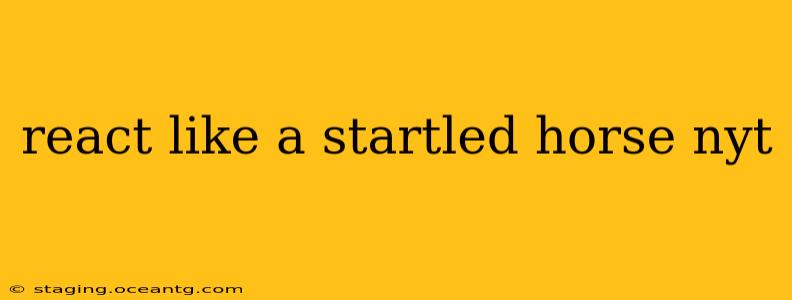React Like a Startled Horse: NYT Coverage and the Power of Metaphor
The New York Times, known for its incisive reporting and impactful storytelling, often employs powerful metaphors to capture the essence of complex events and human experiences. The phrase "react like a startled horse," while not a direct NYT headline, encapsulates a common narrative thread found across their diverse coverage. This phrase evokes a specific image: a sudden, involuntary, and potentially forceful response to an unexpected stimulus. Let's explore how this metaphor plays out in different contexts within NYT reporting.
What Does "React Like a Startled Horse" Mean in the Context of NYT Reporting?
The phrase suggests a reaction characterized by:
- Suddenness: The event prompting the reaction is unexpected and jolting.
- Instinctiveness: The response is primal, emotional, and not necessarily rational or calculated.
- Potentially Unpredictable Outcomes: The horse's reaction could range from a simple jump to a wild, uncontrolled flight, highlighting the unpredictability of the situation.
This metaphor applies across numerous NYT articles, particularly when describing:
-
Political Reactions: A sudden policy shift by a government, or the unexpected outcome of an election, can leave individuals and institutions reacting like startled horses – scrambling to adjust and adapt. The NYT might detail the chaotic aftermath, focusing on the unforeseen consequences and the frantic efforts to regain control.
-
Economic Upheaval: A market crash, a sudden surge in inflation, or unexpected economic news can trigger panic and frantic responses among investors and businesses. The NYT's coverage would likely focus on the speed and intensity of the reaction, examining its impact on various sectors.
-
Social and Cultural Shifts: The rapid spread of a new technology, a shocking social media trend, or a sudden change in public opinion can leave society feeling disoriented and reacting instinctively. The NYT might delve into the underlying causes of the change and analyze the range of responses it provokes.
-
Personal Reactions to Trauma: While less explicit, the metaphor can also apply to individuals coping with personal tragedy or unexpected life events. The NYT might explore the disorienting effects of trauma and the individual's struggle to regain stability.
How Does the NYT Use Metaphor to Enhance its Storytelling?
The NYT's use of metaphor, including the implied "startled horse" reaction, serves several crucial purposes:
- Accessibility: Metaphors translate complex ideas into relatable images, making complex events more understandable to a broad audience.
- Emotional Impact: A well-chosen metaphor can evoke strong emotional responses, increasing reader engagement and making the story more memorable.
- Conciseness: Metaphors can convey a wealth of information efficiently, capturing the essence of a situation in a few evocative words.
- Nuance: The metaphor subtly suggests additional layers of meaning, allowing for more nuanced storytelling.
What Other Metaphors Does the NYT Employ?
The NYT's masterful use of language extends beyond this specific metaphor. They frequently use other powerful imagery to create vivid and memorable narratives, enriching their reporting and analyses. Think of the consistent use of evocative descriptions when detailing natural disasters, political maneuvering, or social movements. These carefully chosen words shape public understanding and influence how we perceive events.
Conclusion: The Power of Metaphor in Journalism
The implied "react like a startled horse" metaphor serves as a potent example of how the NYT employs figurative language to enhance its reporting. By using evocative imagery, the NYT transcends simple fact-reporting, crafting narratives that are both informative and deeply resonant with readers. Their masterful use of language helps them capture the complexities of the human experience and the unpredictable nature of the world around us.
